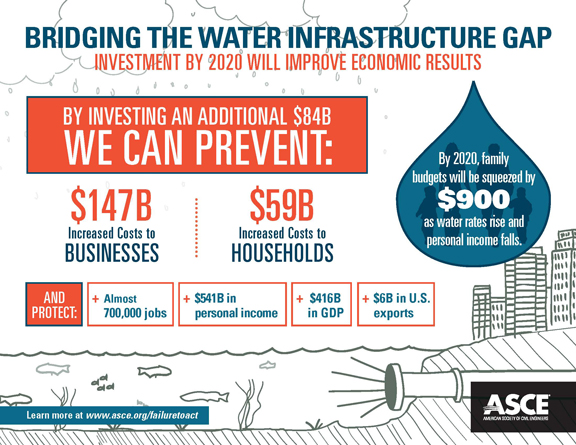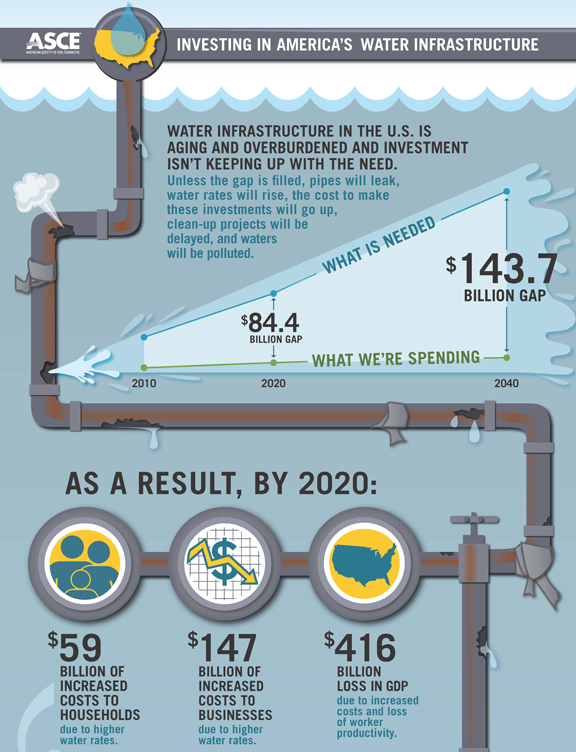AMERICAN SOCIETY OF CIVIL ENGINEERS
EXECUTIVE SUMMARY
Of all the infrastructure types, water is the most fundamental to life, and is irreplaceable for drinking, cooking, and bathing. Farms in many regions cannot grow crops without irrigation. Government offices, hospitals, restaurants, hotels, and other commercial establishments cannot operate without clean water. Moreover, many industries—food and chemical manufacturing and power plants, for example—could not operate without the clean water that is a component of finished products or that is used for industrial processes or cooling. Drinking-water systems collect source water from rivers and lakes, remove pollutants, and distribute safe water. Wastewater systems collect used water and sewage, remove contaminants, and discharge clean water back into the nation’s rivers and lakes for future use. Wet weather investments, such as sanitary sewer overflows, prevent various types of pollutants like sewage, heavy metals, or fertilizer from lawns from ever reaching the waterways.
However, the delivery of water in the United States is decentralized and strained. Nearly 170,000 public drinking-water systems are located across the U.S. Of these systems, 54,000 are community water systems that collectively serve more than 264 million people. The remaining 114,000 are non-community water systems, such as those for campgrounds and schools. Significantly, more than half of public drinking-water systems serve fewer than 500 people.
As the U.S. population has increased, the percentage served by public water systems has also increased. Each year new water lines are constructed to connect more distant dwellers to centralized systems, continuing to add users to aging systems. Although new pipes are being added to expand service areas, drinking-water systems degrade over time, with the useful life of component parts ranging from 15 to 95 years.
Particularly in the country’s older cities, much of the drinking-water infrastructure is old and in need of replacement. Failures in drinking-water infrastructure can result in water disruptions, impediments to emergency response, and damage to other types of essential infrastructure. In extreme situations caused by failing infrastructure or drought, water shortages may result in unsanitary conditions, increasing the likelihood of public health issues.
The United States has far fewer public wastewater systems than drinking-water systems—approximately 14,780 wastewater treatment facilities and 19,739 wastewater pipe systems as of 2008.1 In 2002, 98 percent of publicly owned treatment systems were municipally owned. Although access to centralized treatment systems is widespread, the condition of many of these systems is also poor, with aging pipes and inadequate capacity leading to the discharge of an estimated 900 billion gallons of untreated sewage each year.
The EPA estimated the cost of the capital investment that is required to maintain and upgrade drinking-water and wastewater treatment systems across the U.S. in 2010 as $91 billion. However, only $36 billion of this $91 billion needed was funded, leaving a capital funding gap of nearly $55 billion.
Water infrastructure in the United States is clearly aging, and investment is not able to keep up with the need. This study’s findings indicate that investment needs will continue to escalate. As shown in table 1, if current trends persist, the investment required will amount to $126 billion by 2020, and the anticipated capital funding gap will be $84 billion. Moreover, by 2040, the needs for capital investment will amount to $195 billion and the funding gap will have escalated to $144 billion, unless strategies to address the gap are implemented in the intervening years to alter these trends.
Download full executive summary (PDF): Failure to Act
About the American Society of Civil Engineers
www.asce.org
“Founded in 1852, the American Society of Civil Engineers (ASCE) represents more than 147,000 members of the civil engineering profession worldwide, and is America’s oldest national engineering society. ASCE’s vision is to position engineers as global leaders building a better quality of life…Comprised of Regional Councils, Younger Member Councils, Sections, Branches, Student Chapters and Clubs and International Student Groups, the Society and its volunteers are fully engaged in making this a better world by design.”








 RSS Feed
RSS Feed